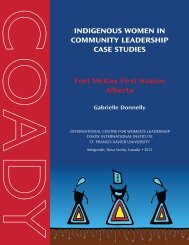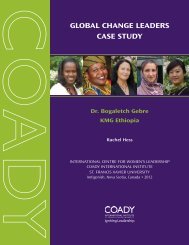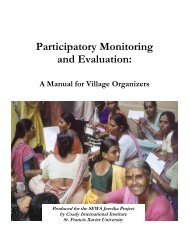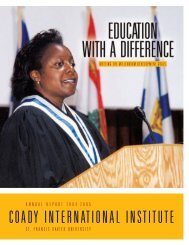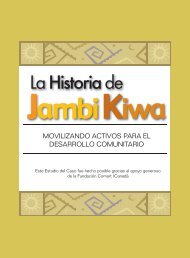Rosa's Story - Coady International Institute - St. Francis Xavier ...
Rosa's Story - Coady International Institute - St. Francis Xavier ...
Rosa's Story - Coady International Institute - St. Francis Xavier ...
Create successful ePaper yourself
Turn your PDF publications into a flip-book with our unique Google optimized e-Paper software.
that were part of indigenous<br />
culture in Chimborazo<br />
province. From the Spanish<br />
conquest until the 1960s<br />
there were few independent<br />
indigenous communities. “The<br />
most important relationship<br />
for many household survival<br />
strategies was the ‘vertical’<br />
link to the hacienda, rather<br />
than ‘horizontal’ ties among<br />
families” (World Bank, 2000).<br />
One of the most influential<br />
factors that changed this<br />
dynamic was the active<br />
involvement of the Catholic<br />
Jambi Kiwa members from Pungol preparing<br />
plants for shipping to the factory<br />
Church. Bishop Proaño played a strong role in breaking up the haciendas controlled<br />
by the Church and in promoting community initiatives through the diocese’s pastoral<br />
program. Jambi Kiwa built on these efforts to create producer organizations<br />
at the village, zonal and provincial levels. Over the past two generations, communities<br />
like Cuatro Esquinas have built bonding social capital through communitydriven<br />
projects requiring the expansion of local social networks (see figure 6).<br />
As Cuatro Esquinas resident Luis Guamán explains, the community works well<br />
together, since individuals have respect and confidence in one another: “This person<br />
beside me is my neighbour, but I treat him like a brother. If we have some differences,<br />
[or if] something goes wrong between us, I don’t go and complain. I go and<br />
talk with him” (personal communication, October 14, 2004). The consequence of this<br />
dialogue, he says, is a common vision for developing the community together.<br />
Jambi Kiwa has created a grassroots organization by building on the bonding social<br />
capital at the family and community levels and developing bridging relationships<br />
with members across various districts of Chimborazo. Rosa explains that Jambi<br />
Kiwa is rooted in families and groups of families, strengthened by each branch or<br />
zonal group, and crowned with the Association itself. She illustrates how relationships<br />
are supported at the zonal level: “We have monthly meetings [to] plan the<br />
community work, the harvests, what is to be planted and the maintenance needed<br />
in the gardens” (personal communication, October 14, 2004).<br />
Jambi Kiwa’s network of external relationships is evidence that it has “bridged”<br />
22




